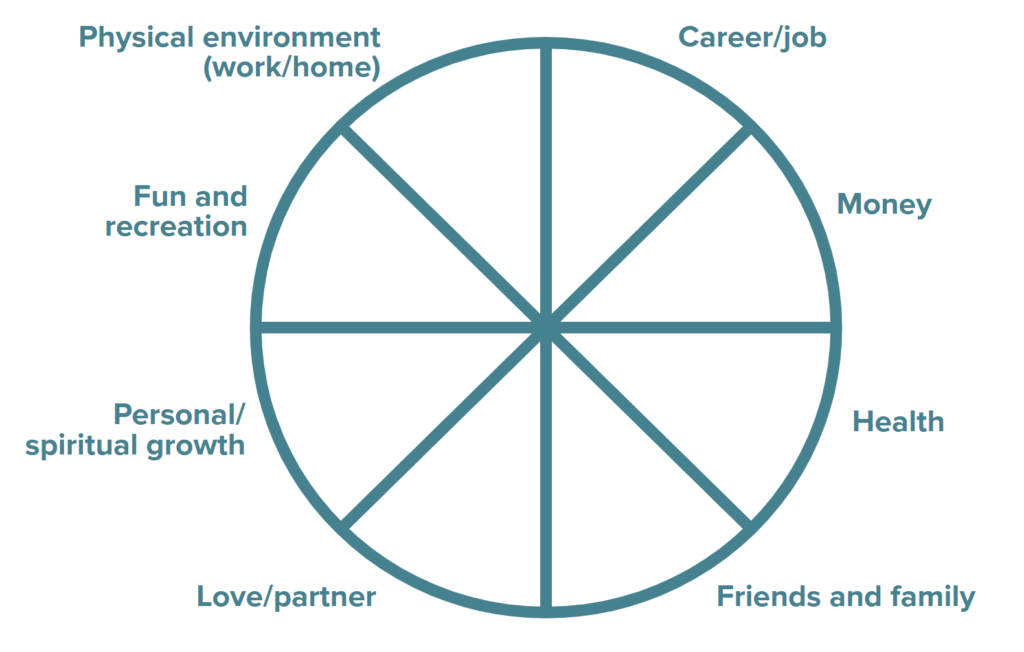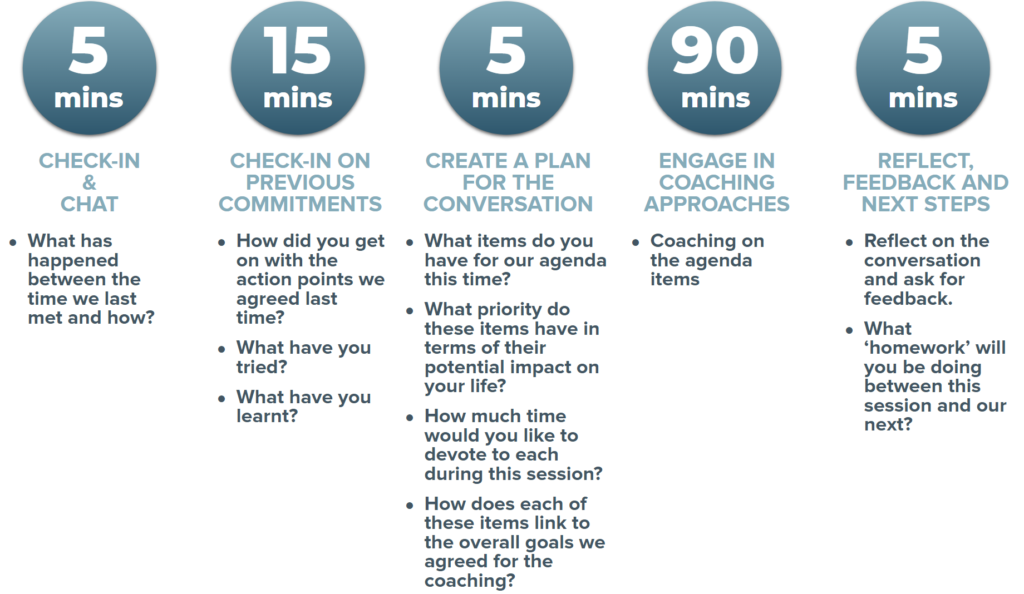What is Coaching
Jenny Rogers (2016) defines coaching as “the art of facilitating another person’s learning, development, well-being and performance. The aim of coaching is to close the gap between people’s potential and their current state.” According to Rogers (2016), coaching not only helps to raise self-awareness but also in determining options by finding solutions, developing skills, and altering attitudes and behaviors.
Coaching vs. Mentoring
You might have heard the terms coach and mentor being used interchangeably. However, there are key differences between coaching and mentoring that are worth exploring (Turnbull, 2009). Both disciplines require different skill sets and relationships. Understanding the differences between a coach and a mentor will help guide us in knowing which approach to employ depending on the situation.
The table below provides a summary of key differences between mentoring and coaching.
| COACHING | MENTORING | |
| Generic helping skills that can be applied to different contexts | Skills/Knowledge | Expert knowledge/experience in a particular area |
| Depends upon creating a sharing trustful relationship | Relationship | Relationship depends on different status between mentor and mentee |
| Avoids giving advice | Advice | Gives advice |
| Maintains a belief that people can find their own answers | Problem-Solving | Offers answers from their own experience |
| High level of skills in precision questioning and reflecting | Skill Focus | High level of skill in their area of expertise |
| Coachee has ownership of change and development | Change Driver | Mentor provides a role-model for potential change |
| Provides a blend of support with high challenge | Support | Provides a blend of support with advice |
| Takes the perspective of the whole person in order to focus on solutions | Focus | Takes a focus on specific issues/tasks |
Upon reflection of the above summary, I recognize that I have been playing the role of mentor more often. I am usually quick to jump into the advice trap and provide solutions when dealing with direct reports. I call this the “microwave” approach. To become a better coach, I will need to modify my approach during formal coaching sessions and allow room for coachees to find their own answers, just like “slow-cooking”.
Coaching Preparation
Before meeting with your coaching client, there are 2 key questions that Aguilar (2013) recommends the coach to prepare for:
- Where does my client need to go?
- Who do I need to be?
Rogers (2016) also recommends that clients share any recent feedback, performance appraisals, recent psychometric test results, and even their resume prior to the first meeting. All this background information on the client will help the coach to better prepare for the first session and shorten the discovery phase.
The Life Scan Wheel
The Life Scan Wheel is a tool used by coaches to get their clients to assess their satisfaction with their life as it is now, in relation to how they would like to be. Coaches usually get their clients to complete this exercise before meeting up for the first time as it is a good way for the client to conveniently express to the coach the state of their life currently (Rogers, 2016).
The client is asked to assess each area of their life, represented by each wedge, and to place a dot along the satisfaction scale in each wedge. The outer edge represents total satisfaction (10) while the center represents zero satisfaction (0). The client then draws a line connecting each dot to discover the wheel that emerges.
When meeting up with the client, the coach then asks the client to talk through their thinking behind how they have scored each wedge.

Wheel Alternatives
There can also be other alternatives to the wheel. For instance, the client can be encouraged to define their own categories (Rogers, 2016). The flexibility of this tool leads me to contemplate what this might look like in a work setting where the coaching agenda has been more well defined. Perhaps the coach might pre-define the categories based on work-related goals for the coachee to contemplate their competence in each area, thus helping discover self-perceived strengths and weakness areas to work on during the coaching relationship.
The Coaching Session
Coaching sessions may vary enormously when it comes to session as well as program length. A typical session may last between 1.5 to 2 hours, and the program length could be a single session or a series of sessions. The goals of coaching may also vary (Rogers, 2016).
Rogers (2016) explains that there are normally 2 to 3 topics in each session and a good session should end with the coachee walking out with a plan of action addressing their goals. Here is a framework prescribed by Rogers (2016).

A Template for the First Session
The first session may require a little more care and planning as most clients tend to feel nervous, not knowing what to expect especially when rapport and trust have not been established. Rogers (2016) presents a guide for coaches to navigate the first session better, assuming a 90-minute session:
| The welcome (5 mins) |
• Welcome client warmly and set them at ease • Offer drinks • Introduce coaching venue and where you will be working |
| Recap reason for coaching (5 mins) |
• Recap briefly the reason for the coaching session based on what you know. • Ask the client to do the same. |
| Contracting (6-10 mins) |
• Explain briefly that the session will have a different shape and feel from what follows. Explain why. • Be prepared to recontract every time you meet with the client. • Ask for the client’s perception of coaching. • Offer your own view of coaching. • Discuss how the coaching partnership is different from other types of one-to-one work. • Ask for successful examples of coaching from the client’s experience. • Discuss the implications of how the client would like to be coached. • Ask the client: “What do you need to know about me?” • Explain accountability with an emphasis on how it is different from traditional boss-subordinate accountability. • Discuss roles and responsibilities. • Assure client of confidentiality. • Explain your practice on note-taking • Agree on frequency, session-length, and method for coaching |
| Autobiography (15-30mins) |
• Ask client for brief account of significant life events starting from childhood. • Explain that early life shapes who we become, our beliefs, and perception of the world as adults. • Ask for connections to their primary reasons for coming to coaching |
| The Life Scan Wheel (10 mins) |
• Explain purpose of the Life Scan Wheel. • Ask client to walk you through their answers. • Coach client through their answers. |
| Review previous development experiences (10-15 mins) |
• Ask client for previous development experiences and their key takeaways. • Review together any feedback or materials the client has sent through. • Discuss tools and techniques that can help the client reach their goals. • Raise the question of bringing in input from client’s line manager on what the organization expects from the coaching. |
| Overall goal-setting (20 mins) |
• Discuss coaching goals derived from professional and organizational needs. • Refer to the Life Scan Wheel for additional goals. • Recontract if goals seem too modest. |
| Feedback (3-5 mins) |
• Ask client for feedback on the session. |
| Mechanics (3 mins) |
• Agree on dates and times for next 2 sessions. • Wrap up and end session. |
| After the session | • Write up notes and file them in a safe and secure place immediately. • Email client summarizing and confirming coaching arrangements. |
Coaching Sentence Stems
Becoming a good coach and a natural one requires skill that comes with much practice. I found the summary of question stems provided by Aguilar (2013) to be incredibly useful for making conversations smoother and building trust. The following are slightly modified versions of question stems based on ten categories defined by Aguilar (2013) which will prove useful in a Coach’s Toolbox.
Active Listening Stems
- What I hear is … Is there anything else you feel I should know?
- So, I’m hearing you say … Did I miss anything?
- As I listen, I hear you say … Is that correct?
- So …
- In other words …
Clarifying Stems
- When you say … what do you mean by it?
- So are you suggesting …?
- Can you tell me more about …
- I’d love to hear more about …
- Could you give me an example of … to help me understand?
- I’m curious, tell me more about …
- I wonder …
- I’m really interested in …
- I’m fascinated by …
- Tell me more about …
- Tell me how … is similar to / different from …
Nonjudgmental Responses
- I noticed that when you …, people really …
- What did you do to make the product so effective?
- I’m keen to hear more about …
- I’m really interested to learn more about …
Probing Stems
- How might you have approached it differently?
- What would it look like if …?
- What’s another way you might …?
- How is … similar to / different from …?
- What do you think might happen if …?
- How do you thin this might impact …?
- What do you think …?
- How did you come to decide …?
- When have you experienced …?
Cathartic Stems
- I sense that you’re feeling … How about we explore and unpack that for a bit?
- What do you see right now? Would you like to discuss how you’re feeling?
- That must feel so …! I’d be … too if it were me. Do you feel very strongly about …?
Catalytic Stems
- Tell me about a time when … What action did you take then?
- It seems like you’re struggling with… How do you plan to approach …?
- I’m hearing quite a number of things from what you’ve just said. You mentioned … How important is this to your work?
- It sounds like you’re disappointed in … How might you do things differently if given the chance?
Supportive Stems
- I noticed that whenever you … your colleagues really … (insert positive observation)
- I really like how you … (insert positive observation)
- It sounds like you have a plan in place already! I can’t wait to see your progress!
- What was it that you do to create such a positive …?
- Your tenacity is really inspiring to me.
- I really admire how positive you are despite the challenges you’ve faced.
- I’m confident that you will find a solution to this.
- That’s inspiring! Tell me more about …
Confrontational Stems
- I’d love for you to share more about … Would this be alright?
- Would you be willing to walk me through your reasoning behind this?
- Would you be open to sharing more about your thinking behind this?
- How might you do this differently?
- What would it look like if …?
- How is this similar to / different from …?
- I noticed … What do you think is going on there?
- What benchmarks did you use to …?
- How might this impact …?
Informative Stems
- I came across a useful video about…
- You can visit … to get more information on …
- An effective method to …. is …
- You can find … in …
Prescriptive Stems
- Have you spoken to … about …? You mentioned you were going to catch up with her.
- Would it be alright if I shared some advice on this topic? I think it might help you. No obligations to take the advice, of course.
- I’d like to suggest …
- I would like to discuss … with …
Don’t miss the other parts in this series on Successful Coaching:
- Successful Coaching Part 1: A Study on Coaching Effectiveness
- Successful Coaching Part 2: The Art of Changing Minds
References
- Aguilar, E. (2013). Art of coaching: Effective strategies for school transformation. Jossey-Bass.
- Rogers, J. (2016). Coaching skills: The definitive guide to being a coach. Open University Press.
- Turnbull, J. (2009). Coaching for learning: A practical guide for encouraging learning. Continuum.


This is such an interesting post! The table that clearly shows the differences between coaching and mentoring was incredibly helpful, and I realized that I have been using these terms interchangeably as well. This could serve as guidance for anyone starting in coaching and determined to do so well.
What a powerful reflection on your coaching work. I appreciate the great set of resources for organizing coaching meetings and tools for shaping coaching discussions. I would be really interested in how valuable you find Rogers tool for shaping a first coaching meeting if you apply it to your own coaching work.
I found the Life Scan Wheel tool to be quite useful as it gets the coaches to do a self-audit before coming to the first session. It also gives the coach something to “break the ice” with and serve as a talking point in the first session. However, to use this in a work setting, I’d probably modify the categories to fit different areas and components related to work